Malaysian fruits, when in season, are such a masterpiece of a perfect combination of tropical, exotic, and floral themes. You can enjoy them raw or utilize their juice to make some marvelous Malaysian beverages.
If you have a chance to travel to Malaysia, you will see many sellers trade fruits in their makeshift stalls along the street. That said, it is just an iconic and beautiful picture in Malaysia.
And now, I will walk you through the list where the category will be divided based on the fruits’ color. Stay tuned for more exciting things ahead!

5 Exotic Malaysian Green Fruits To Enrich Your Fruit Collection
Here I have a basket of green fruits in Malaysia to broaden your knowledge. This section will include cempedak, limau bali (pomelo), limau kasturi, durian, and namnam.
1. Limau Bali (Pomelo)

Limau bali (pomelo or pummelo) is the largest citrus fruit belonging to the citrus family. Its hometown is located in Southeast Asia and usually appears at various festivals.
This sizable pear-shaped fruit usually weighs between 1 – 2kg (2.2 to 4.4 pounds). It has thick skin with a dense, spongy pith inside. The perfect pulp is often sweet and juicy and a bit bitter. On the other hand, some versions will have a dry and sour taste.
Pomelo contains seeds but depending on each variation, that will have fewer or more seeds. The fruit offers tasty juice and a thick rind, which can be candied and enjoyed as a dessert or side dish.
Besides being delicious, limau bali offers human health a considerable benefit. It has a great source of vitamin C. One-quarter of this fruit will give 130% of the amount of vitamin C needed in a day. Also, pomelo is a fine tonic for cough, sore throat, fever, and fatigue.
Nutrients: Provide you with energy, fiber, and vitamin C.
Season: Pomelo trees mainly produce fruits from August to October.
How to eat: Usually consumed raw without the thick rind, or you can enjoy it in the form of juices, desserts, fruit salads, and beverages (alcoholic and non-alcoholic).
2. Limau Kasturi (Calamansi)

Limau kasturi (or calamansi, calamondin, etc.) is an indigenous fruit in Indonesia, the Philippines, Malaysia, Southeast Asia, and southern China. Calamansi may look a bit like tangerine because it crosses between kumquat and mandarin orange.
The trees belong to a shrub ranging from 3 to 6m (9.8-19.7 ft). Limau kasturi has a small round shape with the usual green rind. Besides, you may see other variations like the green stripes on yellow fruit.
Inside, the center flesh and orange juice are covered with a thin piece of pith. In Southeast Asia, calamansi is a famous ingredient for delicacies, condiments, and beverages with its sourness.
In some countries, people apply the juice to remove the fishy smell. Also, the fully ripe one is used for making a cake (calamondin cake), coulis, marmalade, and jam.
Nowadays, calamansi is widely produced outside Asia, such as in sunny California, southern Arizona, southern Texas, and Arizona. More significantly, this tree has achieved the Award of Garden Merit from the British Royal Horticultural Society.
Nutrients: High in vitamin C, A, potassium, and calcium.
Season: It’s available year-round, but the peak season is mid-August to October.
How to eat: Commonly used as beverages such as calamansi juice.
3. Cempedak

Cempedak (chempedak, artocarpus integer, etc.) is native to Southeast Asia, especially Malaysia. Cempedak is also a native fruit in Thailand and some parts of Indonesia.
Typically, cempedak trees reach 12 meters in height, but sometimes, some can grow up to 20m. This tropical fruit usually ranges from 10 to 15 cm in breadth and 20 to 34 cm in length. Its spiky skin will be greenish, yellowish to brownish.
Cempedak tree is related to breadfruit and jackfruit. Although cempedak is smaller than jackfruit, it still presents a similar taste: sweetness with a tinge of durian.
When it’s ripe, the fleshy pulp of cempedak will have darker yellow, juicy, slippery, soft, a bit firm, and fibrous. People usually describe cempedak’s aroma as intense as the smell of durian.
You can serve cempedak right away or cook it with many recipes. And don’t be surprised when knowing the fact that its seeds are edible. Also, they adapt to many kinds of cooking techniques such as frying, boiling, or even grilling.
Nutrients: Rich in antioxidants, dietary fiber, and vitamin C.
Season: In southern Malaysia, fruits develop from February to April and then again from August to October.
How to eat: It will be wonderful if you eat fresh. Besides, unripe ones can be an ingredient in other delicacies (curry is a great example!).
Want to understand cempedak deeply? I’ve got you!
4. Durian
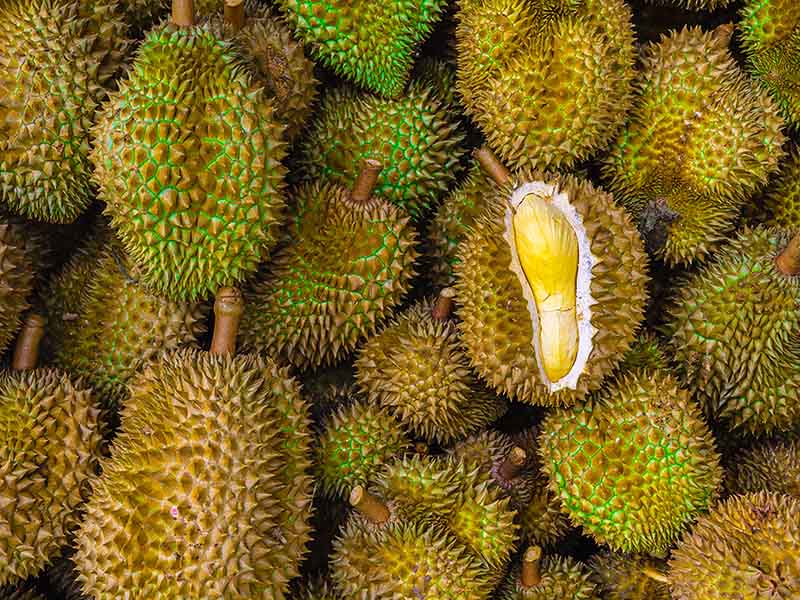
Do you agree that durian is Southeast Asia’s unique tropical fruit? If you still don’t know about durian, that’s a big mistake!
Durian is a major local growth in Malaysia, Indonesia, Thailand, and the Philippines. You will be shocked to know this fruit has hundreds of varieties in Malaysia and the neighboring major fruit-producer Thailand.
Durian trees can grow up to 25-40 meters, having one or two blossom and harvest periods a year. This king of fruits has an oblong to round-large size with a spiky and hard peel. The current name “durian” originated in the Malay language, meaning “thorn” in English.
On the outside, durian presents a green to brown color; on the inside, its flesh will be pale yellow to red. Some people find durian’s aroma unpleasant, intense, and uncomfortable. They often define the odor as rotten onions, bad eggs, and raw sewage.
Still, the flesh will bring you a sweet, rich, and custardy taste with a soft and creamy touch. You will know durian is ripe and ready to eat when its peel starts cracking. However, that still depends on different species and various regions.
Nutrients: Rich in fiber, vitamin C, and vitamin B complex.
Season: The harvest usually starts in mid-June before ending in August.
How to eat: Remove the thorn peel to enjoy the flesh as fresh as possible. Besides, you can use it in Malaysian culinary delights such as ice kacang and ketan durian.
5. Puki Anjing (Nam-Nam)
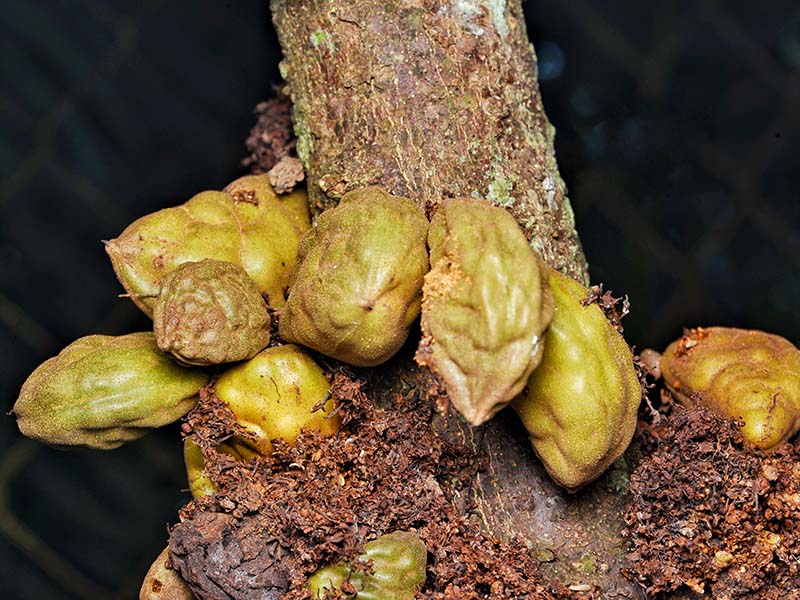
The scientific name of puki anjing is Cynometra cauliflora. It is a native fruit of Malaysia and is primarily found in several mainland Southeast Asian countries. The tree has a small and cauliflorous appearance.
Puki anjing in each country will have different names, such as nam-nam (its common name), namu-namu (Indonesia), or nang-ai (Thailand).
Puki anjing is a kidney-shaped fruit with 5 – 10cm in length and around 5cm in breadth. Its skin has a rugose and uneven texture, which usually has a pale greenish, yellow, or brown color, or a mix of the three.
The pulp has a juicy yellow texture which covers a fairly large seed. Another notable thing about the fruit is that its seed can be extracted into oil to cure leprosy and other skin diseases.
Besides, the sweetness of puki anjing will be proportional to its maturity. It often presents a pleasant and sharp flavor.
Nutrients: Antioxidant.
Season: Occurs between August and November.
How to eat: Enjoy fresh, or you cook namnam with sugar to make a compote. Also, you can use it to make salad and pickles.
4 Gorgeous Red Fruits In Malaysia To Surprise You
Among Malaysia’s red fruits, I think you know most about the famous rambutan. However, the country has plenty of other options: pulasan, Malay rose apple, and santol are also worth a bite!
6. Pulasan

Pulasan is a tropical member of the soapberry family Sapindaceae. This fruit is native to Western Malaysia, especially in lowland primary forests with high levels of humidity.
Apart from being produced popularly in Southeast Asia, this fruit rarely grows in other places. Local Malaysians usually call this fruit with the name rambutan-kafri or rambutan paroh.
Pulasan has an oval shape of around 2 to 3 in (5-7.5cm). Its peel can range from the thick rind with the tubercle surface to thick, fleshy, and straight spines (usually 1cm long).
Many people sometimes confuse it with rambutan. Compared with rambutan, the pulasan’s white or yellowish-white flesh tastes much sweeter. It is usually separated from the seed but still attached to a seed coat.
The seed with a light-brown ovoid or oblong shape is edible and somewhat tastes like almond. Therefore, you can boil or roast the seeds to make cocoa-like drinks.
Nutrients: Vitamin C, fiber, and protein (tiny amount).
Season: The harvest season starts in July-November and March-July.
How to eat: You should eat the fruit fresh after eliminating the skin. Besides, you can make pulasan ice cream, puddings, and jam jellies.
7. Malay Rose Apple

The Malay rose apple is a flowering tree that originated in Malesia and Australia. People also call this fruit by a variety of names, such as mountain apple, rose apple, Otaheite apple, and pink satin-ash.
Based on historical records, Austronesian peoples cultivated the trees and introduced them to Remote Oceania through migration. Currently, this rose apple is gaining popularity throughout the tropics as well as Southeast Asia.
The Malay rose apple is oblong-shaped with a red to dark red color (some have white or pink peels). The pulp inside is white, and the seed is relatively large.
This fruit usually delivers a subtly sweet taste with a crisp and a bit juicy texture. Also, some will have a super slightly tart and bitter aftertaste.
Nutrients: Protein, fiber, calcium, iron, vitamin A and C.
Season: Around July or August.
How to eat: You can consume the whole fruit except the seed. Also, using rose apples to make wines, syrup, jam, or salads is highly recommended.
8. Santol

Regarding Santol’s origin, the fruit can be found in Southeast Asia, but its cultivation also takes place in South Asia, Australia, etc. It is one of the best seasonal tropical fruits.
Santol (sentul or cotton fruit) is divided into two types: the yellow variant and the red variant. However, the red santol seems more popular than the yellow one. Also, the reddish leaves combined with green leaves feature the unique attractiveness of the tree.
The fruit often has a similar shape, size, and a slightly fuzzy texture to the peach. The skin can vary from thin to a thick consistency. And when it comes to the thick one, you can use a spoon to enjoy both pith and flesh inside.
The white pulp inside contains inedible brown seeds and might look like the inside of a mangosteen. Depending on maturity and species, santol can deliver a sweet or sour taste with a mild peach – and apple-like tinge.
Nutrients: Iron, vitamin C, calcium, and phosphorus.
Season: Available in the late spring through fall.
How to eat: You should consume santol fresh or turn it into beverages, jams, jellies, and syrups.
9. Rambutan
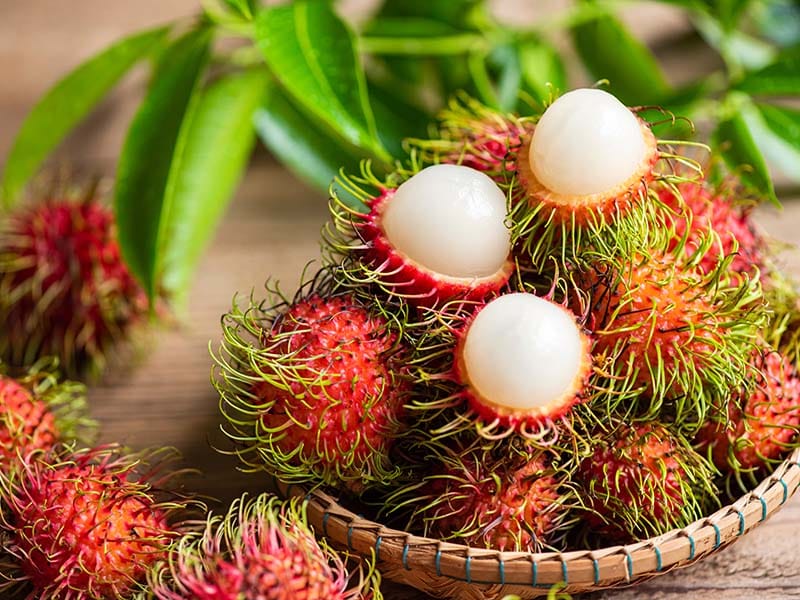
To be honest, the rambutan is always on the top of my favorite fruit list. The fruit belongs to the Sapindaceae family and is widely produced in Southeast Asia. This fruit is associated with other tropical fruits such as pulasan, lychee longan, and mamoncillo.
People also grow the fruit in some parts of East Africa, India, and South America. In 1906, people tried to bring rambutan seeds to the Southeastern United States, but the effort failed, except in Puerto Rico.
The name rambutan literally means “hair” in Malay because the fruit has reddish (orange or yellow), fleshy, and bendable hairy skin.
Its shape is round to oval, 3-6cm long and 3-4cm in width (like the golf ball). The flesh inside is translucent, white, or pale pink. It is sweet with a tinge of sour and floral tropical taste.
Rambutan is not only tasty but also offers many health benefits, including weight loss and better digestion. But rambutan has a short shelf-life; instead of enjoying it fresh, you can make jams and jellies.
Nutrients: Fiber, vitamin C, copper, iron, zinc, manganese, phosphorus, etc.
Season: The ripe fruit will appear in August and September.
How to eat: You can use teeth, fingers, or a knife to crack the rind and open them up. Rambutan also is a good element for salads, curries, and desserts.
Some Malaysian Fruits In Yellow Will Amaze You With Its Deliciousness
Let’s pick up and enjoy some yellow fruits! I have carambola, langsat, and cermai. Although I put them into this category, they can change their color as they mature.
10. Carambola (Star Fruit)

Originally from tropical Southeast Asia, carambola (star fruit) also grows well in Brazil, South Asia, the South Pacific, and the United States.
Thousands of years ago, Austronesian traders introduced carambola to the Indian subcontinent and Sri Lanka. Since then, it has become popular in those regions, as well as in East Asia, Oceania, and the Pacific Islands.
There are two major categories of star fruit: the small sour and the larger sweet. Carambola has an oval shape with orange-yellow waxy skin. It ranges from 5 to 15cm in length and has five or six ridges that look like the star in the cross-section.
Each fruit will contain 10 to 12 edible flat light brown seeds. The flesh is translucent with light yellow to golden color. It presents a sweet-sour flavor attached with a hint of the tart taste.
Some people describe carambola’s flavor as a combination of ripe pear, green grape, and orange. Besides, the texture is firm, crunchy, yet still a bit juicy, making the fruit quite unique.
Nutrients: Fiber, protein, vitamin C, B5, and copper.
Season: Star fruit is available year-round, but June-September and November-February are lovely times to enjoy fresh star fruit.
How to eat: Wash it carefully and enjoy the whole fruit. It’s also a wonderful ingredient for salads, iced drinks, and some other chopped spices.
I mean, how can you say no to the delightful carambola?
11. Langsat

Langsat is a native fruit in Southeast Asia (especially western Malaysia) that belongs to the Mahogany family. In Terengganu Malay, people usually call it dokong. Meanwhile, in Indonesia, langsat is known as the name duku.
Just like other fruits, langsat will have plenty of different variations, but generally, it will be divided into two main groups of cultivars: duku and langsat. Besides, a mixed duku-langsat hybrid also exists.
Duku fruit types are large with a round shape. It has thick, brownish skin with fuzzy yellow hair that usually doesn’t secrete sap if you cook the fruit. By contrast, langsat has an ellipsoid shape with thin skin. Unlike duku, this one will release a white sap while cooking.
Overall, their flesh consists of clear-white lobes that look like peeled garlic. Regarding flavor, people describe it as a combination of grape and grapefruit. The fruit provides a sweet and sour taste, a watery and juicy texture, and an aromatic odor.
Nutrients: Vitamin A, fiber, protein, calcium, etc.
Season: June-July and December-January or even until February.
How to eat: You bite the peel to crack it in half and pull the flesh into your mouth. Besides, you can apply different cooking techniques (making candied fruit, for example) to langsat.
12. Cermai (Malay Gooseberry)

You might come across several names for this fruit, such as Malay gooseberry, Otaheite gooseberry, Tahitian gooseberry, star gooseberry, or simply gooseberry tree.
According to some historical records, this tropical or subtropical tree probably stemmed from Madagascar. Then, it spread widely to Asia (particularly the southeastern region) and the Americas.
Cermai has an oblate shape with waxy and glossy skin. When unripe, the fruit is whitish-green, but it gradually turns pale gold to yellow upon reaching maturity.
The pulp inside is usually thin, firm, and juicy, with a typical sour taste. Each fruit will contain 6-8 smooth and globose seeds in a stone at the center.
Cermai’s leaves are considered medicine to treat sciatica, lumbago, and rheumatism. People apply its syrup to enhance the blood supply for the liver and soothe the stomach.
Nutrients: Vitamin C, calcium, and iron.
Season: Mainly harvested in January.
How to eat: Eat fresh or used as flavorings for other dishes. Sometimes, you can candy or pickle them.
Malaysian Fruits In Other Colors That Have No Chance To Disappoint You
In the last section, I will offer you a colorful theme of several fruits to brighten up the day. I believe some of them will match your appetite perfectly with their pleasant flavor!
13. Keranji (Tamarind Plum)

This is widely known as the black velvet tamarind (or tamarind plum) that mainly appears in Southeast Asia. It’s also well-known in many African countries, such as Sierra Leone, the Ivory Coast, Ghana, etc.
This velvet tamarind is a tall, tropical, and fruit-bearing tree from the Fabaceae family. Keranji fruit is small and similar to the grape but has hard brown shells.
The remarkable thing is that its flavor has almost the same taste as tamarind, which explains the name “black velvet tamarind”. However, the pulp inside will offer a sweeter, dryer, and more powdery texture than tamarind.
Each one will have one black, shiny, and round seed, which you may find related to a watermelon seed. Once you taste the flesh, this fruit will be an incredible snack you would love to munch on daily.
Nutrients: Vitamin C, ascorbic acid, calcium, iron, etc.
Season: July to September.
How to eat: Eat the flesh inside without the peel and seed.
What is keranji? Let’s find out more about this fruit here!
14. Kemunting (Rose Myrtle)

Kemunting is an evergreen shrub in Malaysia, parts of China, India, the Philippines, and Indonesia. It’s an evergreen bush that produces the little unique berry-like fruits in season. Unfortunately, you can’t purchase rose myrtle in stores or at markets.
However, you can find kemunting largely in tropical and subtropical areas as a well-known ornament plant in gardens. Besides, it also appears on coasts, natural forests, wetlands, bog margins, etc.
Kemunting fruit is 10-15mm long with purple skin and a round shape. It usually contains three or four cells with 40-45 tiny seeds in each cell. The texture will be richer than other berries, and the flesh is sweet and juicy with an aromatic smell.
In Malaysia, kemunting (fruits, roots, and leaves) can be used as a cure to treat diarrhea. Also, Indonesians sometimes crush kemunting leaves to poultice the wounds.
Nutrients: Protein and anthocyanin.
Season: Mid-May to late August and reach the freshest state in June and July annually.
How to eat: All parts except the skin and seeds are edible. You can apply kemunting for fruit salads, tarts, pies, jellies, and jams.
15. Mangosteen
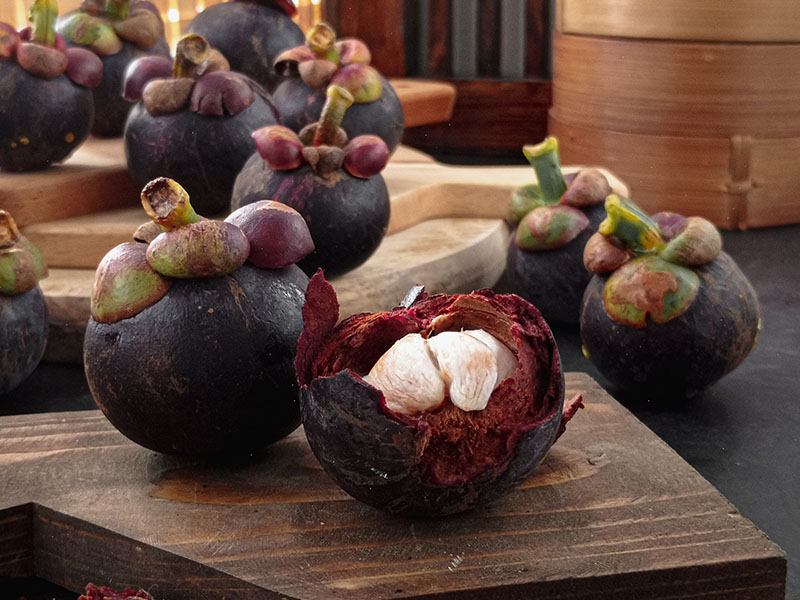
Mangosteen is an exotic fruit mainly produced in Southeast Asia, southwest India, and other tropical regions, including Colombia, Puerto Rico, and Florida.
Accompanying the king of fruit, durian, is the queen of fruit, mangosteen. According to Chinese food therapy, mangosteen is a cooling type of fruit that matches perfectly with the heaty durian.
And when looking at its appearance, I understand why it’s called the queen of fruits. Mangosteen has a size of a small tangerine topped with a stem that looks like the crown of a queen.
The fruit has a thick and firm outer ranging from green to red, and finally a dark purple color when reaching the ripe stage.
The snow-white flesh has segments that are similar to the mandarin orange type. Usually, one mangosteen will have 4-8 segments (some can have up to 9, yet that is a rare occurrence).
It contains an extremely juicy and fibrous texture along with a sweet-sour and tangy taste with a hint of a floral note that will keep your mouth watering.
Nutrients: A rich source of fiber and antioxidants.
Season: From June to August, besides, there is a smaller season between December and January.
How to eat: Enjoy mangosteen fresh by using a knife to cut it deep enough only to crack the shell.
Everything you need to know about mangosteen is here!
16. Jentik
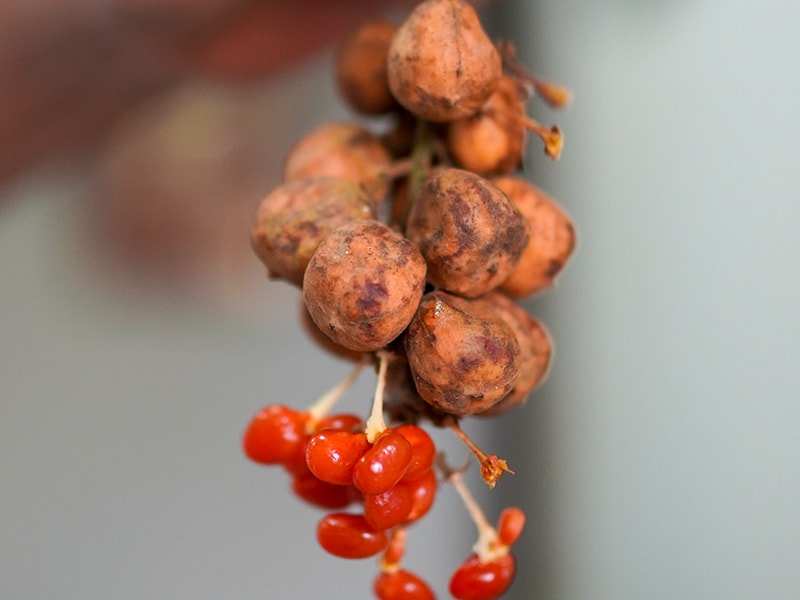
Jentik (or baccaurea polyneura) is derived from Peninsular Malaysia and Sumatra island in Indonesia. The tree has an irregularly-shaped crown that can grow up to 5-30 meters. Also, jentik can reach its best development in mountainsides or alluvial locations.
The fruit looks like mini eggs or an ovoid capsule. Depending on the ripe state, its color will range from evergreen to yellow to orange, and dark brown to white-brown to red-brown color. When it dries out, it will appear browner.
Jentik has a typical sweet-sour taste with a juicy texture, with the avril-like flesh surrounding the flattened seeds. You can find this tropical fruit in local markets.
Nutrients: Antioxidants.
Season: July to September.
How to eat: Remove the peel and enjoy it fresh.
17. Sapodilla

This fruit goes by several names, including sapodilla, sapota, chikko, naseberry, nispero, sapeta, etc. Sapodilla widely grows not only in southern Mexico, Central America, and the Caribbean but also in Malaysia, Viet Nam, India, and Indonesia.
Sapodilla trees are a relatively slow-growing and long-lasting plant coming from the family Sapotaceae. The fruit is considered a large berry that ranges from 4-8cm in width. Sapodilla varies from round, oblate, conical, or oval shapes.
Its saggy skin covers the sandy brown (sometimes pale yellow or reddish-brown) flesh inside. The consistency may be coarse, grainy, or smooth with a malty and subtle sweetness similar to a well-ripened pear.
Each one will have at least one to six seeds (some have up to 12) that are very easy to remove because they’re placed loosely in the center of the fruit. Be careful with those little ones! They can get stuck in your throat for their glossy and slippery touch.
Nutrients: High in fiber, vitamin C, and copper (a mineral to create new blood cells and develop the brain and immune system).
Season: Sapodilla season happens twice a year in Malaysia: in March and November.
How to eat: Remove the skin and seeds, cut them in half, and you can eat the flesh with a spoon. Or you can cut it in 3-4 sections like other typical fruits.
Here is a general introduction to sapodilla.
What Malaysian Fruits Do You Think Will Fulfill Your Refined Palate?
In conclusion, with various sources of exotic Malaysian fruits above, which one will be your utmost favorite? Some fruits you can find easily in Asia markets, yet some require a lot of money and effort to find.
I believe that your thoughts about Malaysian fruits will change with this article, and you might want to enjoy them as soon as possible. If you find this post helpful, you can share it with others and leave your experience in the section below. Thanks a bunch!
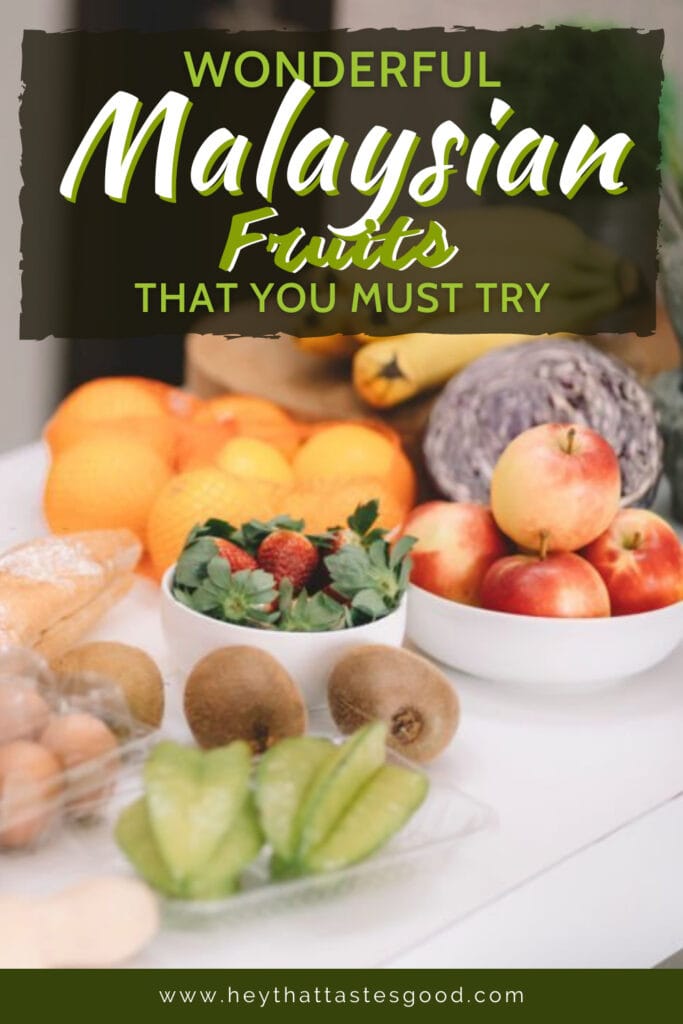


Linda Dean
Expertise
Culinary Arts, Food Journalism, Global Cuisine, Exploration, Recipe Development, Cultural Food Studies, Culinary Travel and Storytelling
Education
Culinary Institute of America, Hyde Park, NY
Program: Associate in Culinary Arts
Focus: Developed a comprehensive understanding of global cuisines and essential cooking techniques. Engaged in intensive hands-on practice in both kitchens and real-world settings, guided by expert chefs. This program emphasized the application of culinary skills in professional environments, preparing students for a variety of roles in the culinary industry.
City, University of London, London, UK
Program: BA Journalism
Focus: Gained expertise in media studies with a strong foundation in reporting, editing, and communicating. While the program focuses broadly on journalism, the skills acquired apply to food journalism, including the ability to analyze and report on food culture and culinary trends effectively.
Linda Dean is an experienced chef and food writer who loves exploring flavors from around the world. Trained at the Culinary Institute of America, Linda has spent over ten years mastering the art of making dishes that truly represent different cultures. She also studied journalism at City, University of London, which helps her write engaging stories about these foods.
On heythattastesgood.com, Linda shares recipes that bring the world’s kitchens to her readers. She focuses on authentic tastes and the stories behind them, making it easy for anyone to try international cuisine at home.